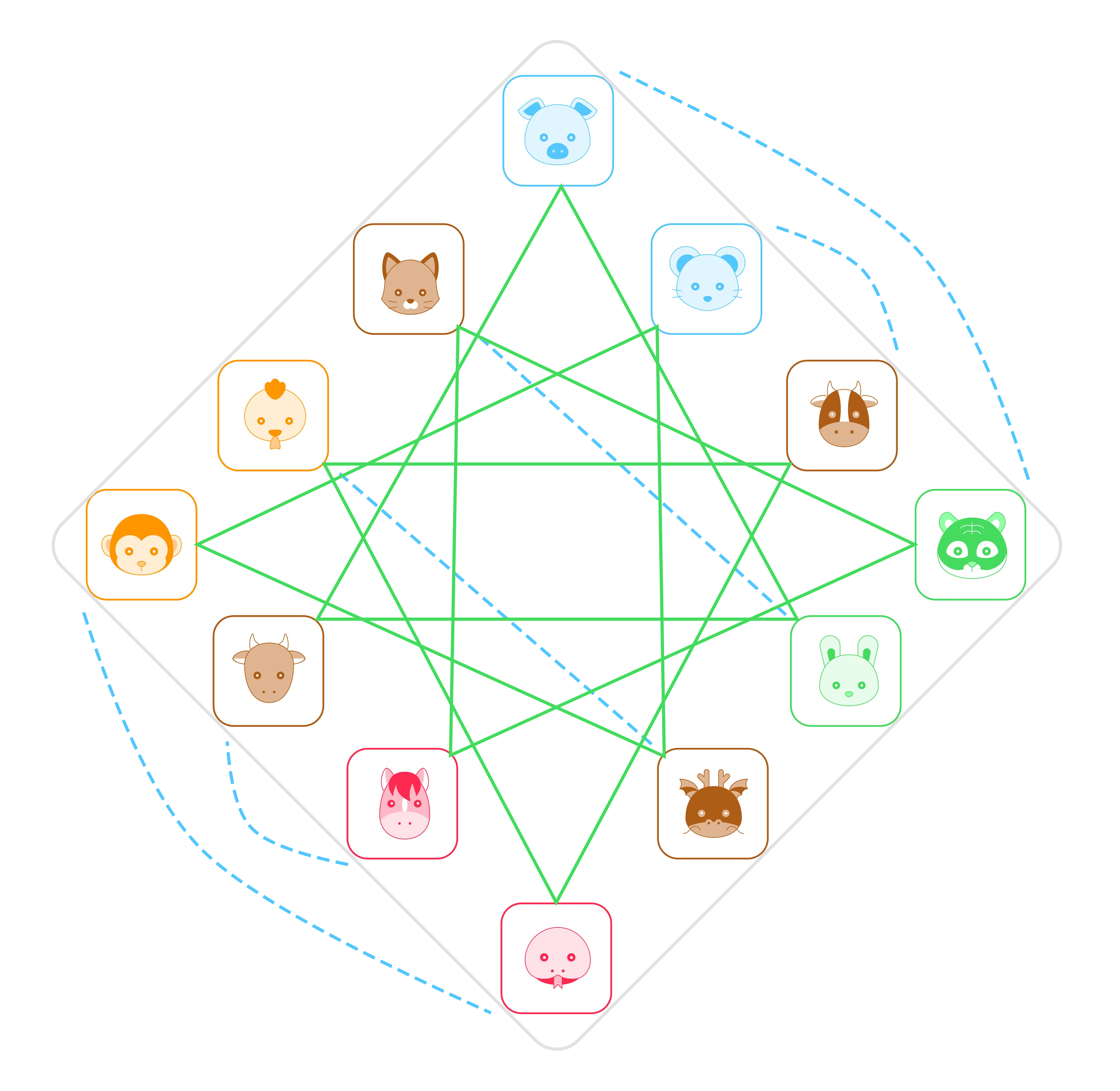10 Master Elements and their ideal natural conditions

To read a BaZi chart effectively, one must apply fundamental natural laws and use images of nature to comprehend the interactions between the various Elements. Each Master Element thrives under specific conditions, making it crucial to understand these requirements for accurate analysis.
We will briefly outline the basic requirements for each Master Element here.
The Master Element is the focal point of every BaZi analysis, representing the individual whose chart is being interpreted. Therefore, the Master Element needs to be supported by the conditions within the surrounding chart. If the other elements in the chart are hostile toward the Master Element, the individual may face challenges in life. In BaZi, the Master Element is located at the top of the Day Pillar.
.
 YANG WOOD
YANG WOOD
Yang Wood represents a tree or large plant. For a tree to thrive, it needs abundant Earth for support, Water (preferably Yin Water) for nourishment, and Yang Fire to provide warmth. The presence of Yang Metal and Yin Fire can be beneficial, as the Wood is cut by the Metal to create Fire, forming a positive and dynamic interaction.
However, Yang Wood may become frustrated by Yin Wood, which tends to use larger trees for support, climbing and growing on top of them. Yang Wood is highly sensitive and requires a balanced set of conditions to flourish. An excess of Yang Metal can be particularly challenging, as it has the potential to cut down Yang Wood completely. Thus, maintaining harmony among these elements is crucial for the well-being of Yang Wood.
 YIN WOOD
YIN WOOD
Yin Wood represents small plants, flowers, and creepers. These delicate forms of vegetation thrive primarily on Yin Earth and Water, with a preference for Yin Water. Some Yin Wood plants can sustain themselves solely on Water, given it is Yin Water, which offers gentle and nurturing hydration.
For Yin Wood to flourish, regular trimming is essential, especially if the plants are robust and healthy. This makes Yang Metal beneficial, as it provides the necessary pruning. Conversely, Yin Metal can be bothersome, causing small cuts that may irritate these delicate plants.
Yin Fire tends to be too intense for Yin Wood, which prefers more moderate warmth. Overly dry conditions are unfavorable, making the gentle heat of the Yang Fire more suitable. Due to its gentle nature, Yin Wood is not very effective on its own and often needs additional Wood to support its growth and climb.
However, if Water is too abundant and there is a lack of Earth, Yin Wood can become overwhelmed and washed away, leading to instability. Therefore, a balanced environment with adequate support from Earth is crucial for the stability and growth of Yin Wood.
 YANG FIRE
YANG FIRE
Yang Fire represents the sun in the sky, the only Element not originating from planet Earth. Yang Fire thrives in the presence of Yang Water, symbolizing a vast ocean. When the sun shines upon the sea, it produces light, a vital substance for life. This interplay between Yang Fire and Yang Water creates one of the most powerful and dynamic interactions within the Five Elements system.
Yang Fire also benefits from the presence of Yin Metal. When these two elements combine, they produce pure, precious Water, forming a potent and harmonious combination that we have detailed in our blog.
Yang Fire, being distant from Earth, cannot produce the Earth Element but can provide essential warmth, particularly beneficial when Earth is cold or frozen. Although Yang Fire does not receive support from Wood, it offers warmth to plants and trees, helping them grow. Essentially, Yang Fire is selfless and does not require much from other Elements; it enjoys providing warmth and light. What Yang Fire does appreciate is occasional recognition and appreciation for its contributions.
The only Element that Yang Fire might find troublesome is Yin Water, which represents clouds. Clouds obscure the sun, preventing Yang Fire from shining fully. Excessive Yin Water can weaken the strength of Yang Fire, leading to diminished energy and a sense of purpose for the individual. Thus, maintaining a balance is crucial to ensure that Yang Fire can continue to thrive and perform its vital role.
 YIN FIRE
YIN FIRE
Yin Fire represents various forms of fire, from a cozy fireplace to an open bonfire or a flickering candle flame. For Yin Fire to thrive, the most crucial Element is Yang Wood, which provides a steady and substantial source of fuel. Yin Wood burns too quickly to be a reliable energy source for Yin Fire. Ideally, the Yang Wood should be relatively dry, meaning the presence of the Water Element should be minimal.
Yin Fire can manage Yang Water fairly well, but Yin Water poses significant challenges. Yin Water, symbolizing dampness and mist, can smother Yin Fire, making it difficult for the fire to maintain its brightness and intensity. Additionally, an excess of the Earth Element can suffocate Yin Fire, as too much ash from the Earth can extinguish the flame.
When Yin Fire is strong and well-supported by a good supply of Wood, it can transform Yang Metal into useful tools and objects. This transformative ability is a unique strength of Yin Fire. However, to remain effective and bright, Yin Fire needs a continuous supply of Wood. Without enough Wood and with an excess of Water, Yin Fire’s energy diminishes, rendering it nearly useless.
Maintaining a balanced environment where Yin Fire can receive the right amount of support from Yang Wood and avoid excesses of Water and Earth is essential for it to perform optimally.
 YANG EARTH
YANG EARTH
Yang Earth represents mountains, rocks, or large boulders, embodying stability and firmness. For Yang Earth to thrive, it needs to remain solid and substantial. Yang Earth benefits greatly from the presence of Yang Water, which provides boundaries and direction to the oceans and rivers, enhancing its strength and purpose.
Yang Earth also has a favorable relationship with Wood. Wood roots into the Earth, providing structure and support. However, if Yang Earth is excessive, it particularly benefits from Yang Wood, whose powerful roots can penetrate deeply and stabilize the Earth.
During winter, when Yang Earth can become cold and inert, the presence of Yang Fire is crucial. Yang Fire provides the necessary warmth to invigorate and energize the Earth, maintaining its vitality.
The Metal Element, symbolizing precious metals found within the earth, brings value and enrichment to Yang Earth. The presence of Metal enhances the intrinsic worth of Yang Earth, representing the treasures hidden within its depths.
In summary, for Yang Earth to remain robust and beneficial, it needs a harmonious balance of Yang Water for direction, Wood for support, Yang Fire for warmth, and Metal for value. This balance ensures that Yang Earth can maintain its stability and fulfill its role effectively.
 YIN EARTH
YIN EARTH
Yin Earth represents soil, gardens, farmland, or deserts, depending on its conditions. Its primary purpose is to support plant growth, which requires both types of Wood. Yin Water is essential to keep Yin Earth moist and fertile.
For Yin Earth to be effective, it must be substantial and thick. If Yin Earth is weak, it risks being washed away by excessive Yang Water or eroded by the roots of Yang Wood. When Yin Earth is born in winter, it needs Yang Fire to provide warmth and vitality.
The Metal Element is also crucial for Yin Earth, as it represents the minerals that enrich the soil, enhancing its nurturing qualities. These minerals are essential for supporting plant life and maintaining the fertility of Yin Earth.
In summary, Yin Earth needs a balance of both types of Wood for growth, Yin Water for moisture, Yang Fire for warmth during the winter, and Metal for its mineral content. This balance ensures that Yin Earth can fulfill its role as a nurturing and supportive element.
 YANG METAL
YANG METAL
Yang Metal represents tools such as axes, knives, or any sharp metal instruments. In its raw form, Yang Metal is unrefined and requires specific conditions to become a useful tool. The presence of Yin Fire and Yang Wood is essential, as they provide the necessary heat and pressure to mold Yang Metal effectively. Yang Wood fuels the fire, while Yin Fire applies the precise pressure needed for shaping.
Yang Metal thrives under pressure, with Yin Fire being the best element to provide this. Yang Fire, while offering warmth, does not supply the necessary pressure that Yang Metal requires.
Although Yang Metal does not excel at producing Water, the presence of Water can be beneficial to cool the chart when Fire and Wood are intense. However, the Water should not be too deep, as excessive Water can cause Yang Metal to sink and lose its effectiveness.
Yang Metal does not fare well with a combination of Yin Earth and Water, as this mixture can make it muddy and dirty. Instead, a combination of Fire and hot Earth makes Yang Metal shiny and more refined. However, the heat should not be too intense, as excessive heat can cause the Metal to become brittle and break. Generally, the Earth element should be kept low, as Yang Metal does not require much Earth to remain healthy and strong.
In summary, Yang Metal needs Yin Fire and Yang Wood for molding, moderate Water to maintain balance, and a controlled amount of heat from Fire and Earth to remain effective and sharp. This balanced environment ensures that Yang Metal can reach its full potential as a refined and useful tool.
 YIN METAL
YIN METAL
Yin Metal represents jewelry and precious metals, which need Yang Fire to shine. Yang Fire illuminates Yin Metal, enhancing its brilliance and beauty. This combination also produces Water, which helps keep Yin Metal clean, making it a highly favorable pairing. Yin Metal thrives in the presence of pure, clean Water, as it enhances its sparkle and luster.
Yin Metal dislikes the combination of Yin Earth and Water, as this makes it dirty, something it detests. It does not mix well with Yang Earth, which can overwhelm its delicate nature.
In terms of its interactions with other elements, Yin Metal is not effective at cutting and cannot control Yang Wood. However, it can trim Yin Wood to some extent, though this combination is more decorative than productive, often referred to as the “Christmas tree effect”—beautiful to see, but not particularly useful.
Yin Fire, while providing necessary pressure, must be balanced carefully. If Yin Fire is too strong, it can break Yin Metal. Thus, the relationship between Yin Metal and Yin Fire needs careful management to ensure that Yin Metal remains intact and radiant.
In summary, Yin Metal needs Yang Fire for illumination and clean Water for purity. It should avoid combinations with Yin Earth and Water to stay pristine. Properly balanced Yin Fire can enhance its qualities, while careful interaction with Wood can create decorative effects without overwhelming its delicate nature.
 YANG WATER
YANG WATER
Yang Water represents expansive bodies of water such as lakes, rivers, and oceans. For Yang Water to be directed and contained, it needs the presence of Yang Earth, which establishes essential boundaries. Without Yang Earth, Yang Water can become directionless, potentially leading individuals to disregard rules and regulations.
In colder climates, especially for those born in winter, Yang Water benefits from the warmth and illumination provided by Yang Fire. This helps maintain its vitality and balance. Additionally, Wood, in any form, is invaluable to Yang Water due to its purification properties. When Yang Water becomes contaminated by Yin Earth, it can lead to legal and moral complications, making the presence of Wood crucial for filtering out impurities and maintaining clarity.
The Metal Element has minimal influence on Yang Water, playing a minor role in shaping its characteristics and interactions. This means that while Metal may be present in the chart, it does not significantly alter the nature or behavior of Yang Water.
 YIN WATER
YIN WATER
Yin Water represents rain, fog, snow, and other forms of precipitation. It provides essential moisture to the Earth, supporting the growth of Wood. When a chart is overly hot, Yin Water is ideal for regulating the temperature, as Earth and Wood absorb it, cooling the environment and even moderating Metal’s heat.
However, excessive Fire can evaporate Yin Water, diminishing its effectiveness. In such cases, Yin Metal can offer support to weak Yin Water, helping it maintain its balance and presence within the chart.
Also published on Medium.



